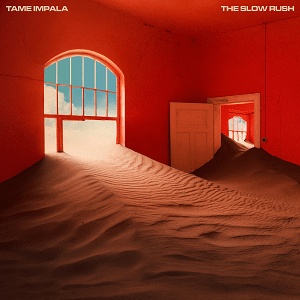Released in February 2020, The Slow Rush marks the fourth studio album from Tame Impala, the psychedelic music project led by Australian multi-instrumentalist Kevin Parker. Arriving five years after the critically acclaimed Currents, this album doesn’t just extend the sonic palette Parker has been refining—it repurposes it to reflect a deeper philosophical shift. Where Currents was driven by emotional transformation and personal reckoning, The Slow Rush leans into the dimension of time itself: how it haunts, heals, and shapes us.
Within the broader music landscape, the album came at a moment when genre boundaries were dissolving faster than ever. Parker, already a revered figure in pop and hip-hop circles due to collaborations with artists like Travis Scott, Kanye West, and Rihanna, used this opportunity to fully embrace a studio-driven, electronic sound. Yet, he did so without abandoning the swirling, psychedelic textures that made his earlier work stand out.
Sonic Exploration

At its core, The Slow Rush is a masterclass in pristine production. Kevin Parker, who wrote, recorded, produced, and mixed the entire album himself, delivers a sound that is both immersive and sharply detailed. Every track feels meticulously layered, as if built grain by grain, until the result is a shimmering, multidimensional sonic landscape. The production is lush without being excessive, and it serves the album’s meditations on time with a polished clarity that feels almost futuristic.
From the opening notes of “One More Year,” it’s clear Parker is leaning heavily into electronic textures. The synths pulse with a hypnotic steadiness, often grounded by intricate drum programming and deep, gliding basslines. Tracks like “Breathe Deeper” and “Glimmer” shimmer with disco-funk undercurrents, while “Tomorrow’s Dust” adds a warm, almost analog haze that recalls vintage soft rock. Despite this variety, the album remains cohesive thanks to Parker’s deft hand at arrangement and pacing.
Vocals are treated less as a front-and-center element and more as part of the sonic fabric. Parker’s signature falsetto often floats above the instrumentation, soaked in reverb and delay. This choice lends a dreamlike quality to the album, reinforcing the theme of slipping through moments in time rather than standing firmly in any one place.
Genre Elements
Genre-wise, The Slow Rush continues Tame Impala’s evolution away from its psychedelic rock roots toward a more fluid and genre-blending identity. There are clear nods to synth-pop, neo-psychedelia, soft funk, and even elements of house and R&B. Yet, the album doesn’t chase trends—it filters these styles through Parker’s distinct aesthetic, which makes the fusion feel natural rather than calculated.
Lyrical Analysis

Lyrically, The Slow Rush is preoccupied with time—not just its passing, but its weight, its consequences, and the strange comfort it sometimes offers. Kevin Parker uses the album as a space to wrestle with aging, missed opportunities, and the desire to live fully in the present without being shackled by the past. Time is both the antagonist and the setting, a force that chases him and a medium through which he reflects.
Recurring motifs include references to years slipping away, the tension between memory and reality, and the allure of reinvention. In “One More Year,” Parker repeats the titular phrase like a mantra, creating a trance-like reflection on the slow erosion of time. “Posthumous Forgiveness” dives deeper, taking a more personal turn as Parker addresses his late father with a mixture of anger, longing, and unresolved grief. It’s one of the album’s most intimate and emotionally raw moments.
The lyrics throughout are often elliptical, veering toward the abstract rather than the confessional. Parker’s writing favors impressionistic imagery and emotional cues over clear narrative arcs. Lines like “There’s no use trying to relate to that older soul” from “Tomorrow’s Dust” invite the listener to fill in the blanks, encouraging introspection rather than offering concrete answers.
Emotional Impact
Despite their abstraction, the lyrics carry a strong emotional pulse. Parker’s delivery—often airy and half-buried in the mix—imbues the words with a sense of vulnerability. The emotional impact lies not in dramatic declarations, but in fleeting realizations and quiet epiphanies. Songs like “Lost in Yesterday” urge us to let go of nostalgia and stop idealizing the past, a message that resonates with understated urgency.
Cohesion and Flow

The Slow Rush unfolds like a seamless dream, with each track flowing naturally into the next, creating a sense of movement that mirrors the album’s central theme. Rather than abrupt shifts or standout singles placed for maximum impact, the record favors a fluid, immersive experience. The pacing is deliberate, with extended intros and outros that allow each song to breathe. This gives the album a meditative quality, encouraging full listens rather than quick dips in and out.
There’s a gentle rise and fall to the track progression. The album opens with the hypnotic pulse of “One More Year,” setting a cyclical tone that is revisited in different forms throughout. From there, songs like “Instant Destiny” and “Borderline” carry an upbeat, almost euphoric energy, which gradually gives way to more introspective and emotionally heavy moments. By the time we reach “Posthumous Forgiveness” and “On Track,” the tempo slows and the focus sharpens, pulling the listener inward. The closer, “One More Hour,” ties the journey together with a powerful sense of finality and self-reflection, completing the loop that the opening track began.
Thematic Consistency
Thematic consistency is one of the album’s greatest strengths. Time, memory, and personal evolution are explored from multiple angles, but always within the same sonic and emotional universe. Even as Parker dabbles in different genres—shifting from synth-pop gloss to funk-driven grooves—there’s a unifying aesthetic that keeps the album grounded. The production choices, lyrical motifs, and vocal treatment all reinforce a singular mood. There are no jarring detours, no throwaway tracks. Everything feels intentional.
Standout Tracks and Moments
While The Slow Rush thrives on its cohesiveness, several tracks rise above the rest as defining moments of both musical ingenuity and emotional depth.
Posthumous Forgiveness
Chief among them is “Posthumous Forgiveness,” a two-part odyssey that finds Kevin Parker confronting the memory of his father. The first half brims with tension—its churning beat and haunting vocal delivery set the tone for a confrontation decades in the making. The transition to the second half, where Parker’s anger dissolves into longing and imagined reconciliation, is one of the album’s most affecting shifts. It’s not just a standout track—it’s a glimpse into the vulnerability that fuels Parker’s songwriting beneath the polished production.
Lost in Yesterday
“Lost in Yesterday” stands out for its danceable rhythm and sharp lyrical message. Wrapped in retro grooves and funk-laced basslines, the song delivers a subtle critique of nostalgia’s seductive pull. Its chorus—“If it calls you, embrace it / If it haunts you, face it”—perfectly captures the album’s central tension between acceptance and regret.
Breathe Deeper
“Breathe Deeper” also deserves attention for its elastic structure and genre-blending flair. Beginning with a silky groove that flirts with R&B, the track takes a sharp left turn near the end into a woozy, synth-heavy breakdown that feels like slipping into a dream. It’s a bold moment of playfulness and experimentation, a reminder that Parker is as much a producer as he is a songwriter.
On Track
Among the quieter triumphs is “On Track,” a slow-building anthem of resilience. Parker’s voice is more exposed here, and the song’s restrained arrangement allows for a direct emotional connection. Its gradual swell into a full-bodied chorus feels earned rather than formulaic, making it one of the album’s most hopeful and grounded entries.
Artistic Contribution and Innovation

The Slow Rush stands as a significant entry not just in Tame Impala’s discography, but within the broader landscape of contemporary psychedelic and electronic pop. Kevin Parker has long occupied a unique space between genres, and this album reinforces his status as a boundary-blurring auteur. Rather than tethering himself to the conventions of psych-rock, Parker continues to bend the genre toward something more modern, more fluid, and more emotionally complex.
In a time when streaming culture often encourages immediacy and single-driven releases, The Slow Rush defies the trend with its album-oriented focus. It doesn’t chase viral hooks or feature-laden collaborations. Instead, it reasserts the value of the album as a unified artistic statement, emphasizing flow, narrative, and sonic cohesion. This approach feels almost radical in today’s fragmented musical environment.
Innovation
One of the album’s most innovative achievements lies in how it blends nostalgic aesthetics with forward-thinking production. Parker draws from disco, soft rock, synth-pop, and ambient music without resorting to pastiche. Tracks like “Is It True” and “Breathe Deeper” filter retro grooves through a glossy, futuristic lens, creating a sound that feels both familiar and refreshingly new. His ability to create intricate, emotionally resonant songs while maintaining complete creative control—from writing to mixing—is a rare feat in pop music today.
Thematically, the album’s sustained focus on time and transformation also sets it apart. It doesn’t just mention these ideas—it builds a sonic architecture around them. The looping rhythms, extended outros, and echo-drenched vocals aren’t just stylistic choices; they’re reflections of the album’s core philosophical preoccupations. This level of conceptual integration, where sound and message reinforce each other so tightly, adds to the album’s artistic weight.
Closing Thoughts

The Slow Rush is a richly textured and emotionally resonant exploration of time’s quiet power. Kevin Parker has crafted an album that rewards patience, both thematically and sonically. Its strengths lie in its impeccable production, atmospheric depth, and the subtle interplay between vulnerability and control. Each track feels like a chapter in a cohesive story, carefully constructed but never rigid, allowing space for personal interpretation and emotional connection.
That said, the album’s meticulous polish can occasionally work against it. For some listeners, the lack of raw edges or more dynamic shifts in tempo may feel like a barrier to immediacy. There are moments where the album floats so gently it risks becoming background music—at least on a first listen. Yet this is also part of its design. The Slow Rush invites reentry, asking to be absorbed over time rather than consumed in a single pass.
In the context of Tame Impala’s discography, the album feels like a natural evolution. It doesn’t radically depart from Currents, but it deepens Parker’s sonic and philosophical explorations. It’s the sound of an artist more confident in his craft, willing to sit with discomfort and ambiguity rather than rushing toward resolution.
Official Rating: 8/10
This score reflects the album’s masterful execution and conceptual ambition. While it may not have the same immediate impact or trailblazing novelty as Lonerism or Currents, The Slow Rush excels in emotional subtlety and sonic craftsmanship. It’s an album that may take time to fully appreciate—fitting for a work so obsessed with the very idea of time. For many listeners, it won’t just be heard; it will be lived with.
